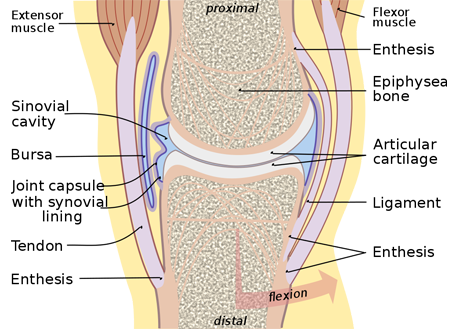Lubrication in the Body
In general, the body is a well-lubricated system with most surfaces which move relative to each other having sufficient fluid to provide fluid friction rather than dry surface friction.
Friction is certainly a concern at load-bearing joints where considerable force acts and there is friction involved in the relative motion of the parts of the joint. Much attention is given to the motion of the parts of the knees. The knees have a remarkable lubrication system employing a thick gel-like liquid called the synovial fluid. Most of the major joints come under the classification of "synovial joints", but the knee serves as an example of the nature of the lubrication. The knee has an inner membrane called the synovial membrane which secretes the synovial fluid as a lubricant, forming a thin layer on the articular cartilages which experience relative movement with large forces pressing them together.
 | Image of knee from Wikipedia reference. |
This lubricant, the synovial fluid in the knees and other joints, receives a lot of attention as a "non-Newtonian fluid". For most liquids, you can characterize the viscosity as a property independent of the pressure exerted upon it and can therefore predict its flow behavior under changing pressure conditions. A fluid is said to be non-Newtonian if its viscosity is not a constant and not linear in its variation. The non-Newtonian characteristic that is invoked for the synovial fluid is that under conditions of sudden increase in pressure as in some kind of mechanical shock, its viscosity suddenly increases. That increase provides some degree of protection to the joint, and then when the excess pressure is removed, the viscosity decreases to its former low value, providing good lubrication for joint movement. There are indications that under other conditions, like normal walking, the viscosity under pressure may decrease instead of increase.
Health Related Concepts
Applications of mechanics
Synovial fluid, Wiki
Non-Newtonian fluids
| HyperPhysics***** Mechanics | R Nave |